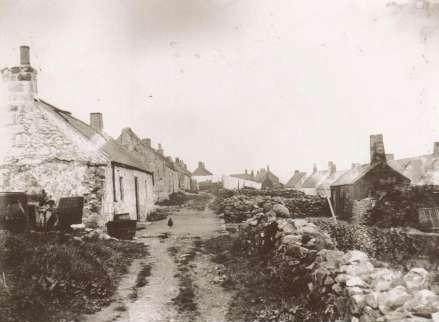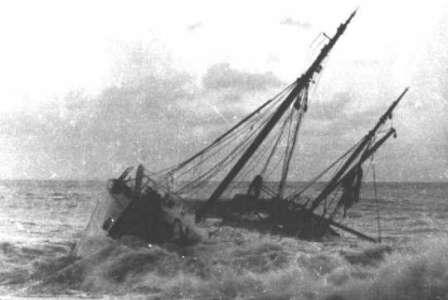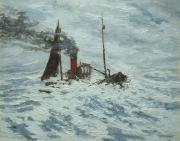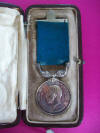
Portlethen Hero (1924) |
 Less than four months after the wrecking of the Lustre
Gem and Craigendarroch there followed a further mishap on the Portlethen
coast within the vicinity of the village. This was the loss of the
Portgordon steam drifter Press Home which foundered on the rocks at
Craigmarroin. Unfortunately the consequences of this incident were more
serious and five men lost their lives but what is perhaps more
remarkable was the survival of three of the crew and the circumstances
behind their survival.
Less than four months after the wrecking of the Lustre
Gem and Craigendarroch there followed a further mishap on the Portlethen
coast within the vicinity of the village. This was the loss of the
Portgordon steam drifter Press Home which foundered on the rocks at
Craigmarroin. Unfortunately the consequences of this incident were more
serious and five men lost their lives but what is perhaps more
remarkable was the survival of three of the crew and the circumstances
behind their survival.
The great feature of this disaster was the bravery displayed by a septuagenarian local fisherman from the village of Portlethen which resulted in three of the crew, skipper Alexander Coull, William Innes and James Coull being saved. Let’s take up the story here.
In the early morning of 26th November 1924 the Press Home went ashore on the rocks at Craigmarroin during a heavy swell and a thick mist. The crew of eight endeavoured to reach the relative safety of the rocks above water level but in those attempts five of them were swept away by the surging seas and drowned. The remaining three, however, succeeded in reaching a high rock located about forty feet from the shore, I suspect that the rock they reached was most likely the Outer Nook at Craigmarroin.
The villagers of Portlethen had already been roused at around 6.30am by the sound of the distress signals from a ship’s siren. George Craig, a seventy year old fisherman was one of nine local fishermen who reached the scene of the drama and when they got there they could make out the figures of three men clinging to a rock about twenty yards distant.
 Several attempts using ropes to reach the stranded men
were made but their efforts were thwarted by an intervening rock which
got in the way. The tide was rising and the position of the three men
was becoming increasingly dangerous, when Craig, who said he knew of
several submerged boulders which could be used as stepping stones to get
to the intervening rock that was hampering the rescue effort,
volunteered to go to their aid. He refused to be dissuaded by his son
and others around him and with rope in hand climbed down to the waters
edge to begin his perilous passage towards the stranded men.
Several attempts using ropes to reach the stranded men
were made but their efforts were thwarted by an intervening rock which
got in the way. The tide was rising and the position of the three men
was becoming increasingly dangerous, when Craig, who said he knew of
several submerged boulders which could be used as stepping stones to get
to the intervening rock that was hampering the rescue effort,
volunteered to go to their aid. He refused to be dissuaded by his son
and others around him and with rope in hand climbed down to the waters
edge to begin his perilous passage towards the stranded men.
He scrambled his way over the boulders and through the surf, at times immersed up to his neck but ultimately succeeded in reaching the projecting rock, ahead of which was the rock where the three surviving men were marooned. One of them, a young man, was scantily clad and in a state of exhaustion so it was decided to attempt to rescue him first. The rope was successfully thrown across the gap of open sea, tied around the man’s waist and Old Craig pulled him through the surf and on to the rock that he himself stood.
This process was repeated in respect to the other two men and soon they were all standing on the same rock and halfway to safety. The rope was then thrown ashore and in turn the three shipwrecked men and their gallant rescuer were hauled on to the beach, all being immersed in the broiling surf in the process.
What did old Craig have to say when questioned about this gallant feat? Well in his own words, as quoted in the press, this was how he recounted it:
“I jist scrambled frae buller to buller, fa’in noo an’ again, bit aye getting’ up. Sometimes the watter wid be up tae ma waist, an’ sometimes up tae ma neck. Still I reached the rock. There were three on the opposite rock, bit nae sign o’ the others. Ane wis in his bare feet, an’ the ither twa shouted tae get him first, as they thocht he wis near gone. They pit the rope aroond his waist, and I pu’ed him to the rock, and then the ithers were pu’ed ower. Fan the men ashore were pu’in me back, I went richt under”.
For his bravery and on the recommendation of the Board of Trade, King George V awarded George Craig the silver medal for gallantry for saving life at sea, and as well as this he received a financial award of £10 from the Board of Trade themselves. Additionally, in the early months of 1925, a well attended reception was held locally in the Jubilee Hall to pay tribute to the man himself.
Photographs of the wreckage of the Press Home near the rocks at Craigmarroin and the Moat.
George Craig, the rescuer, pictured at home in Portlethen Village, aged 75.
Photographs of the actual certificate and medal awarded to George Craig. Reproduced by kind permission of his Great, Great Grandaughter, Elizabeth Gibson.


_small.jpg)



